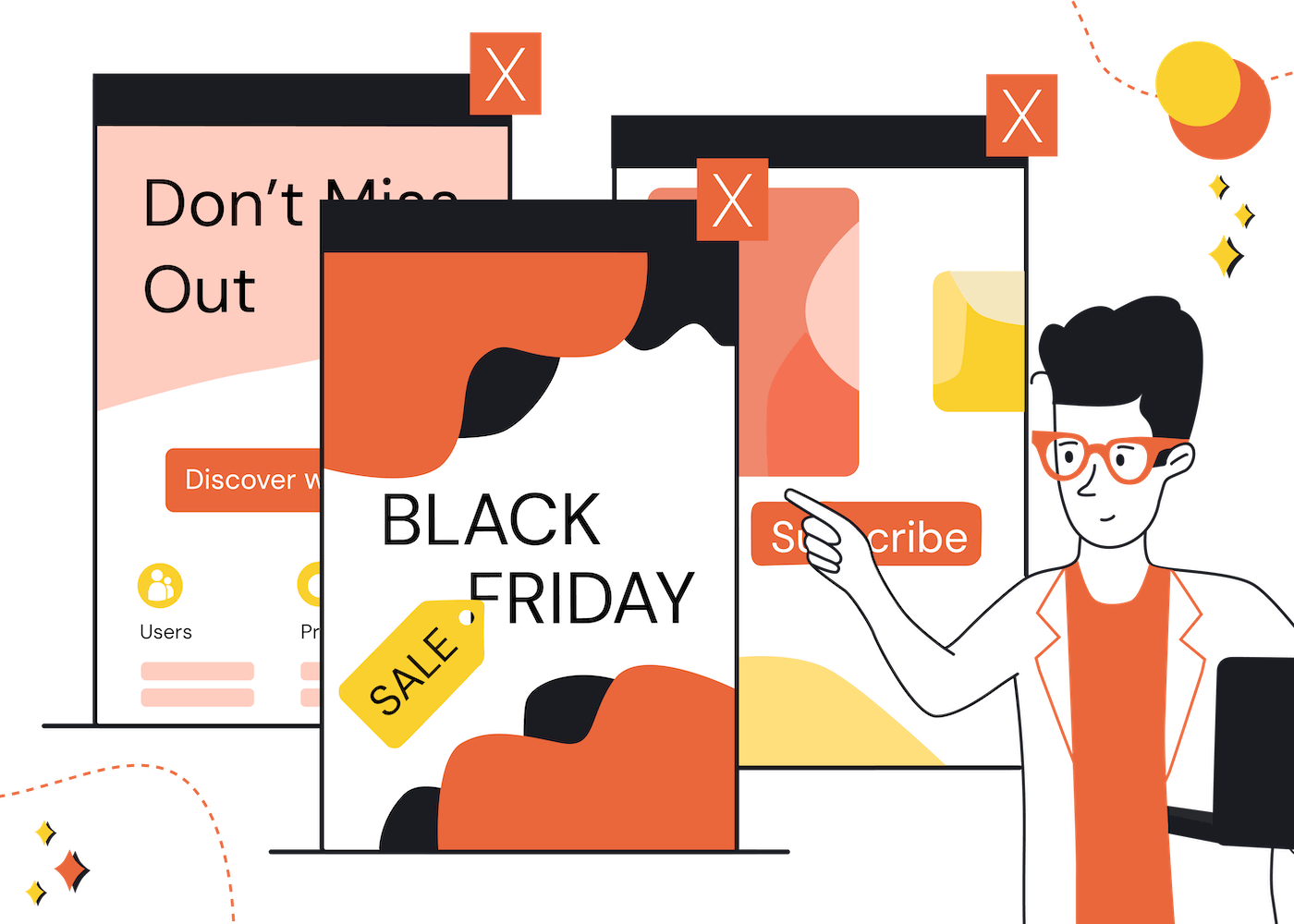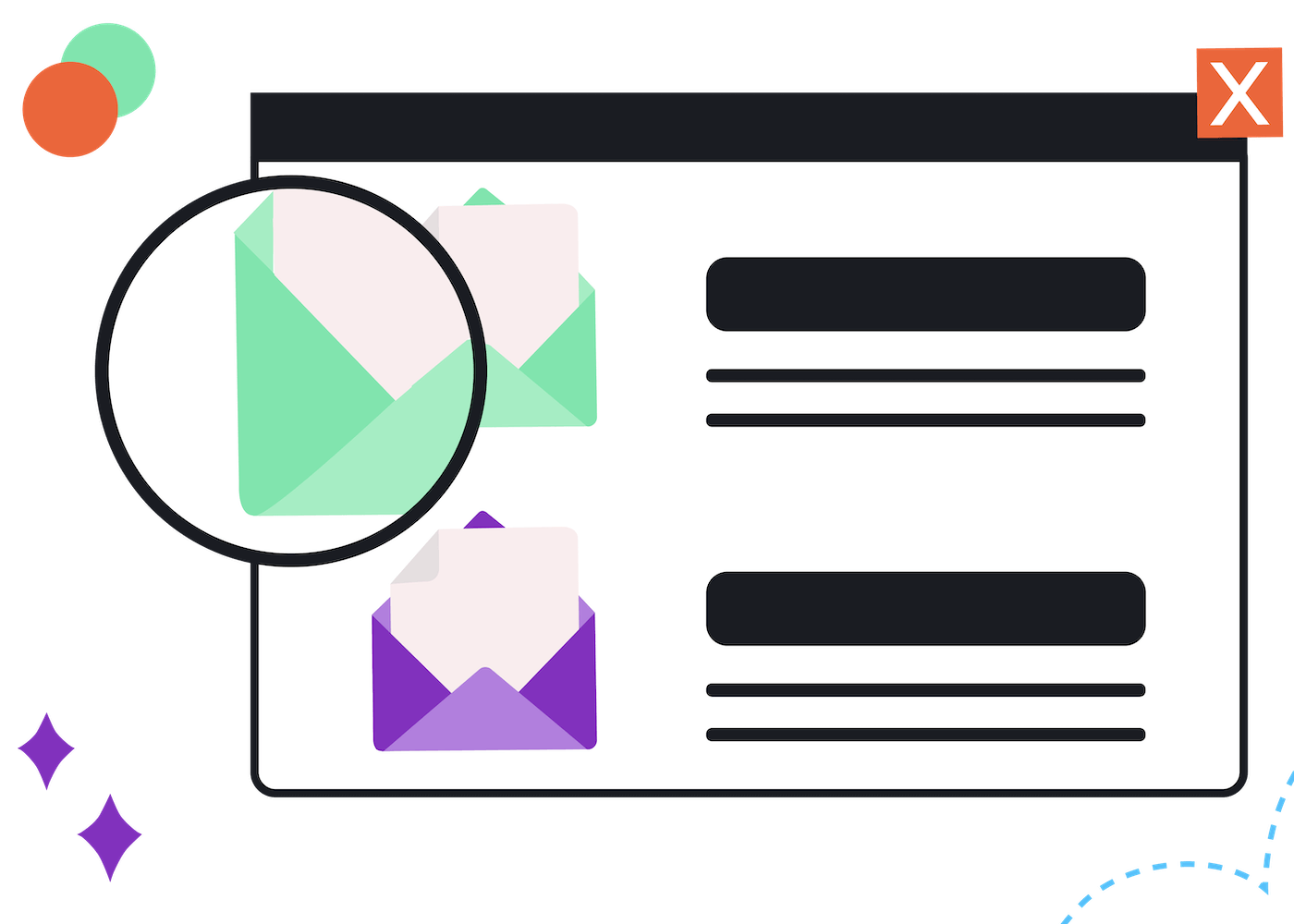Digital ads are far from giving up their reign—they remain an excellent way to get a brand noticed. In fact, global spending is expected to hit $1 trillion by 2026, showing just how much marketers are investing in this channel.
But here’s the rub: Ad fatigue is real. Sixty-one percent of consumers say they are less likely to purchase products when seeing ads too often.
That’s where newsletters sneak in with a smarter play. Instead of chasing eyeballs across feeds, advertising in newsletters allows you to capitalize on the space subscribers have already chosen to open. It feels less like noise and more like part of the reading experience. Marketers can leverage this opportunity to sidestep fatigue and command attention.
Brands aren’t the only ones benefiting from newsletter ads, though.
Newsletter publishers also have a lot to gain from them.
The cost-per-mile (CPM) for a newsletter space ad can range from $15 to $50. Beehiiv also reported that through their ad network, 4,728 newsletters collectively earned $3.7 million in ad revenue in 2024.
So, no matter which side you’re on—a brand marketer or a newsletter publisher—now is the time to learn how to make newsletter ads work for measurable growth.
In this blog post, we’ll examine two important aspects that make this possible: fit and format.
Why Audience Alignment is Crucial for Newsletter Advertising
Fit always comes first. A product has to be relevant to the newsletter audience. Otherwise, no ad format can save it.
Just think:
A CRM tool feels natural in a growth-marketing newsletter. Meditation or journaling apps can be effectively integrated into a wellness newsletter.
Swapping them around would definitely make these ads appear irrelevant and inauthentic. Newsletter creators could lose their credibility, while brands lose the chance to reach their target audiences.
Once you’ve nailed that alignment, the next piece is format. Let’s dive into the five main newsletter ad formats you should know about—and when to use each.
Top 5 Newsletter Ad Formats You Should Know About (+ Examples)
Newsletter ads come in a variety of formats, which brands choose based on their goals or budget.
But these variations don’t only benefit the advertiser – they also let newsletter creators maximize existing ad space or add new slots if they want to expand.
In this section, I’ll walk you through some of the most popular options and explain what they're suitable for. I’ll also give a few real-life examples to make the formats easier to understand and spark ideas for how you can use them in your own business.
Note: As you go through the examples, keep an eye out for how each ad manages to match the audience it’s speaking to. Remember, it’s this alignment that makes newsletter ads feel like a natural recommendation from the publisher.
1. Banners
Best for: Brand awareness, product launches, event announcements, visual storytelling.
The classic. Banners started on websites, but they translate just as well into newsletters. They are mostly image-based, which makes it easier to tell a story at a glance.
You'll find them in several places in a newsletter: header (top), inline (mid-body), or footer (bottom) of a newsletter.
Here’s an example of a header banner from Top of The Funnel (TOFU), a newsletter for content marketers:
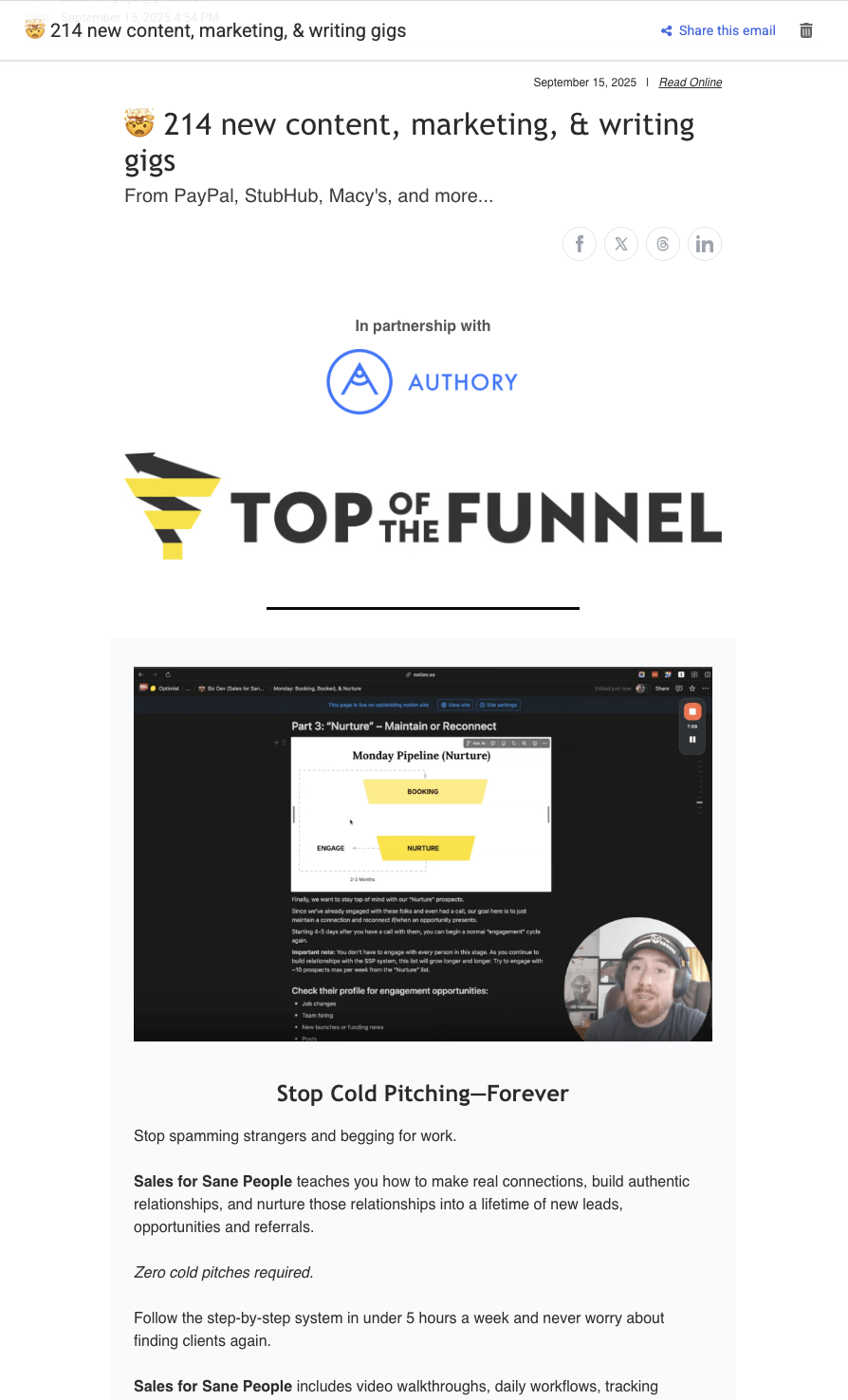
TOFU’s newsletter ad example
A simple banner like Authory’s (which automatically gathers different types of content produced) works best when you want instant impact.
Because of their size and placement, they’re hard to miss—which is exactly what you want when delivering an announcement. They also have enough space to carry visuals, like lifestyle photos, which can convey brand messages more quickly than words can.
But… keep in mind that readers have learned to scroll past them instinctively (a phenomenon known as banner blindness). So you need to work on design quality, message clarity, and context to make them difficult to overlook.
Also, the good news is that banners aren't the only newsletter ad format out there. Below, you'll find options that can blend into the reading flow and might just beat this “classic” format.
Keep reading, you’ll see what I mean.
2. Text ads
Best for: Direct response, subtle promotions, aligning with editorial tone.
Text ads are great for budget-friendly campaigns or when you want minimal disruption to the reader.
They blend seamlessly into the newsletter and feel like part of the experience, while naturally driving attention to the offer. The reason readers don’t tune them out as easily is because they don’t feel like “traditional ads.”
To show you why, I’ll provide examples of two different types of newsletter text ads: sponsored blurbs and inline placements.
Let’s start with sponsored blurbs. This example from Rosie Hoggmascall’s Growth Dives newsletter shows how personal they can be:
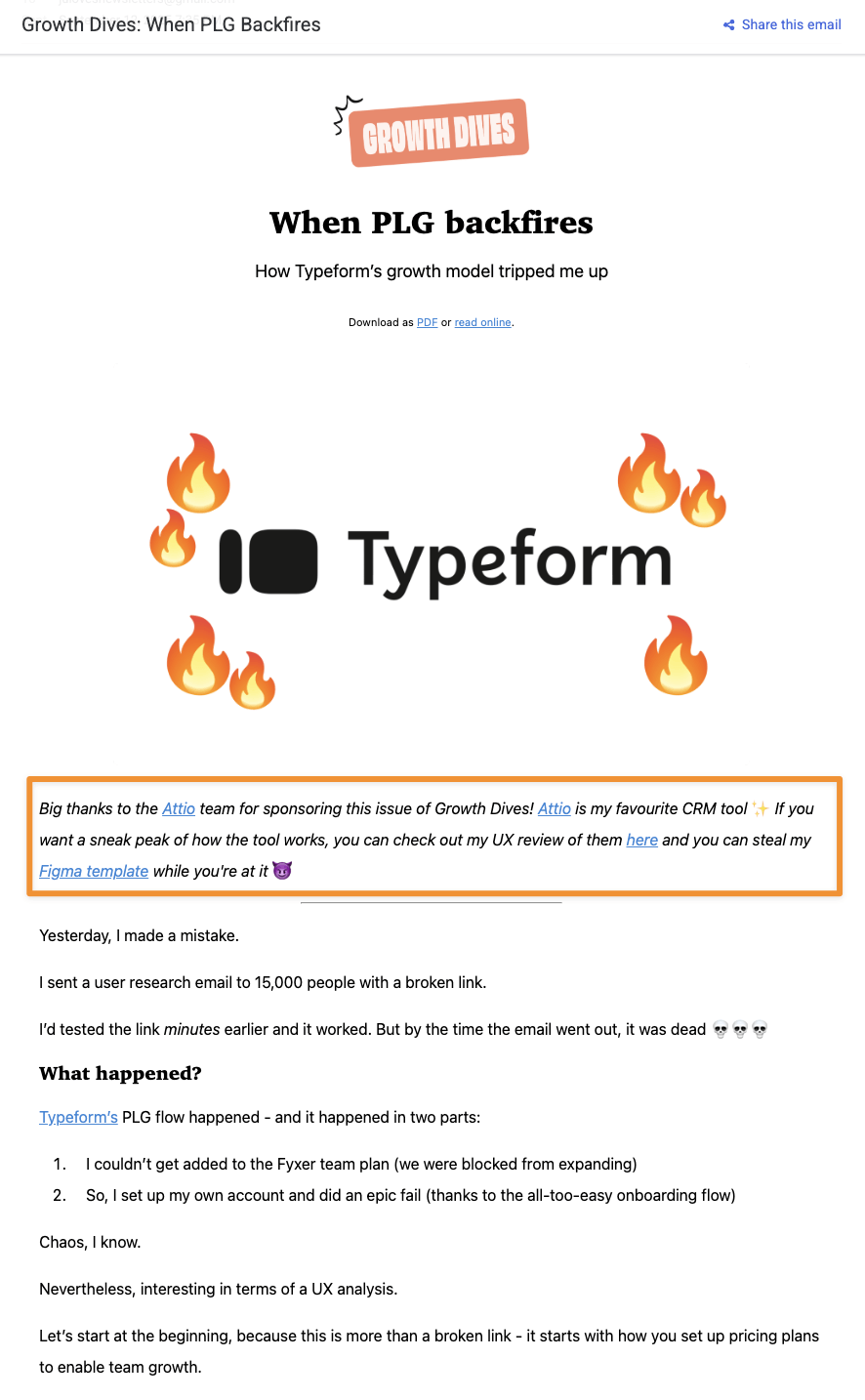
Growth Dive’s newsletter ad example
It’s not just a generic ad because Rosie is using her own voice and has paired it with useful resources like her review and a free template. That personal endorsement makes subscribers of Rosie’s newsletter more curious about how Attio, an advanced CRM tool, can actually fit into their workflow.
Then there’s the inline text ads, which, as the name implies, sit neatly between content blocks. Check out these examples from marketing tools Sprout Social and Canva in this Marketing Brew issue:
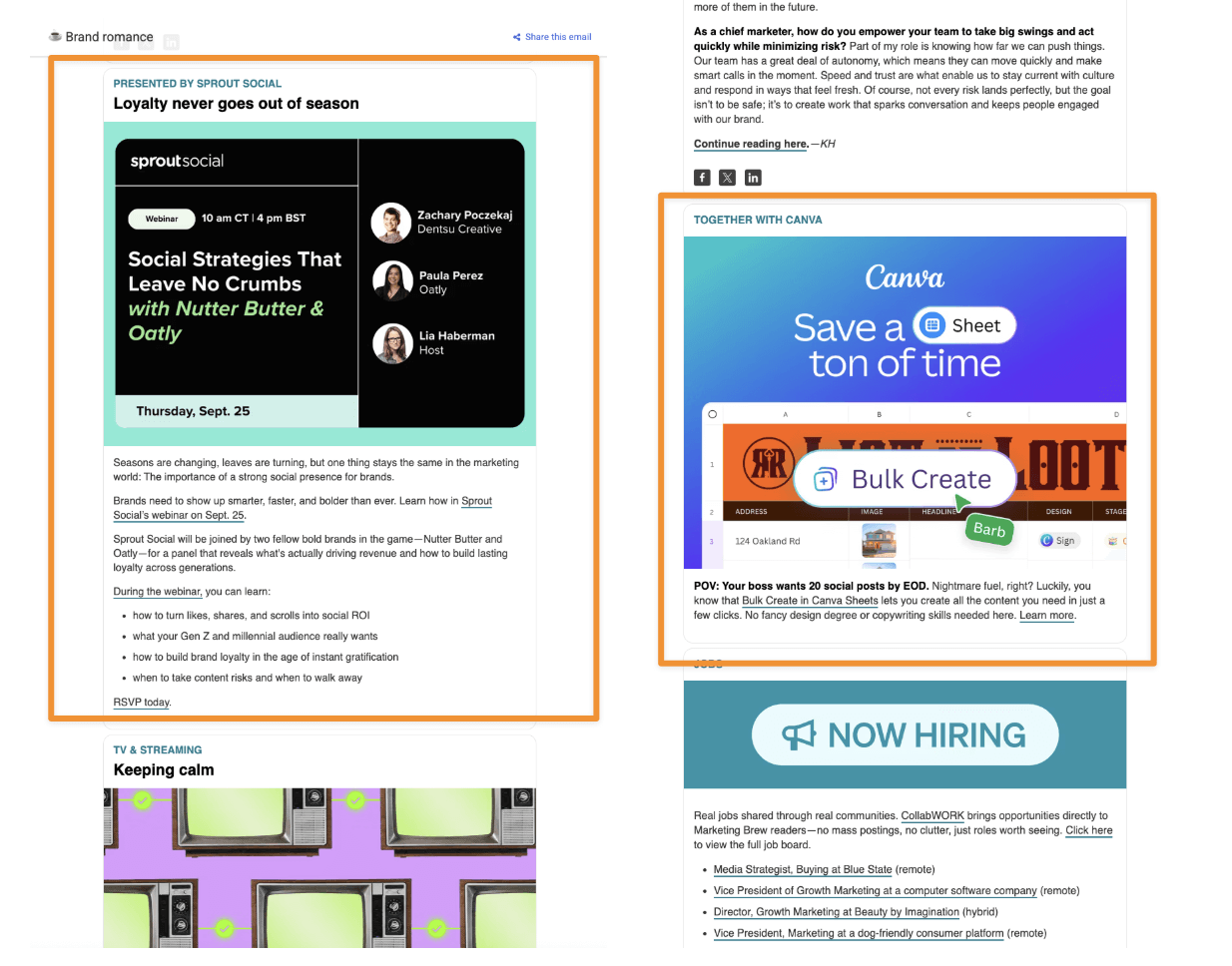
Marketing Brew newsletter ad examples
Why do these work so well? Marketing Brew’s sections, which look like mini-articles, typically follow a “headline + image + short copy” structure.
The ads match that exact rhythm, so they feel like just another piece of content rather than a distraction. If you’re a regular reader, you’re unlikely to scroll past without giving them a glance.
Another reason I like this newsletter ad example is that the copy tone and length match the goal. Sprout Social, for example, was promoting a webinar. That needed a little more explanation to hook readers, so the copy ran longer.
Canva, on the other hand, went short and sharp: it teased a specific pain point for marketers and offered a clear solution with a punchy CTA.
3. Native Placements
Best for: Establishing trust, boosting engagement, aligning closely with content.
Native placements are ads styled to resemble editorial recommendations, usually marked with a small “sponsored” or “partner” label. It’s another newsletter ad format that doesn’t interrupt a subscriber’s reading experience.
Take Mark Manson’s newsletter, for example—he dropped in a recommendation for another newsletter but made sure to flag it as a paid placement:
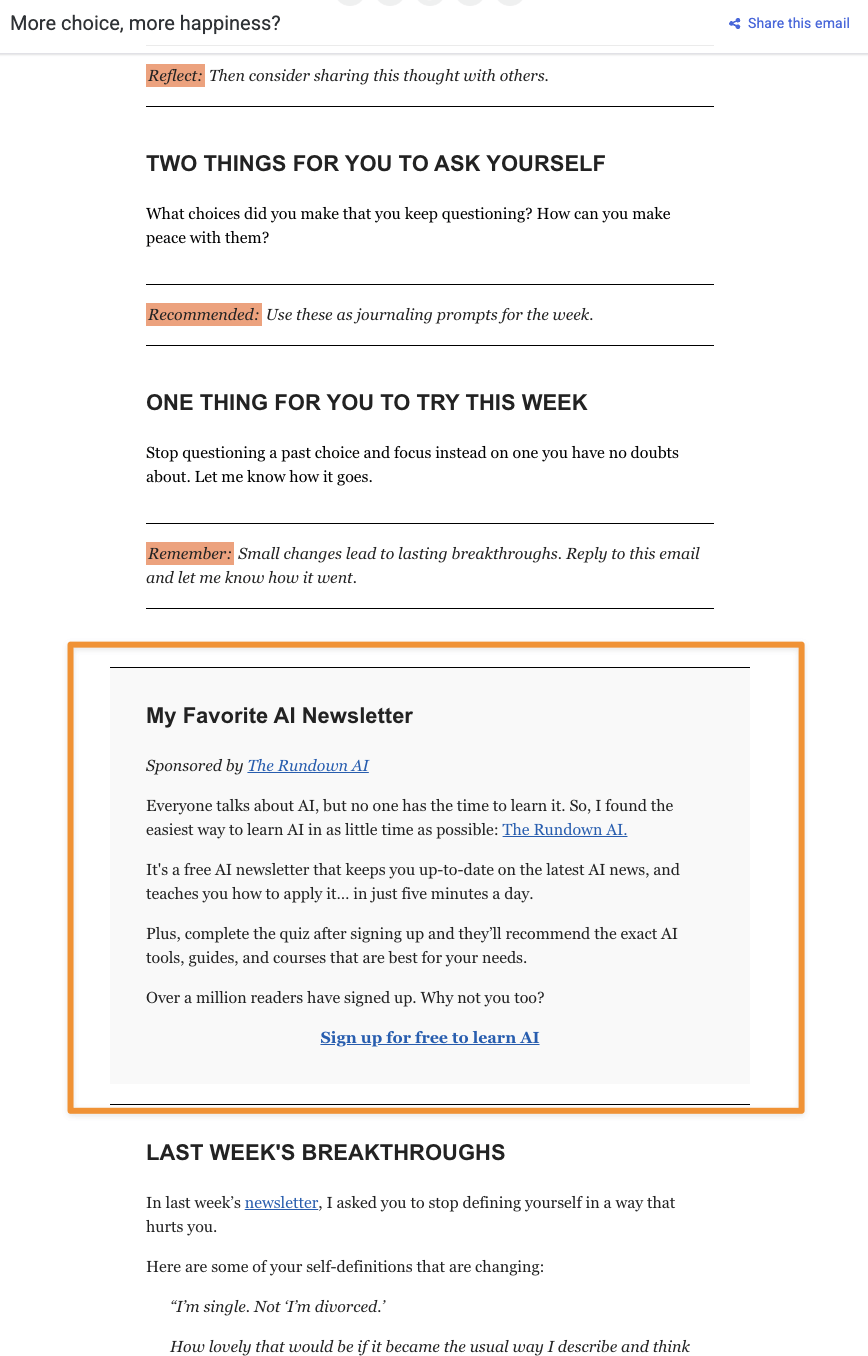
Mark Manson’s newsletter ad example
Here’s our very own example: an ad we ran for email marketing software Omnisend in the EmailTooltester Newsletter:
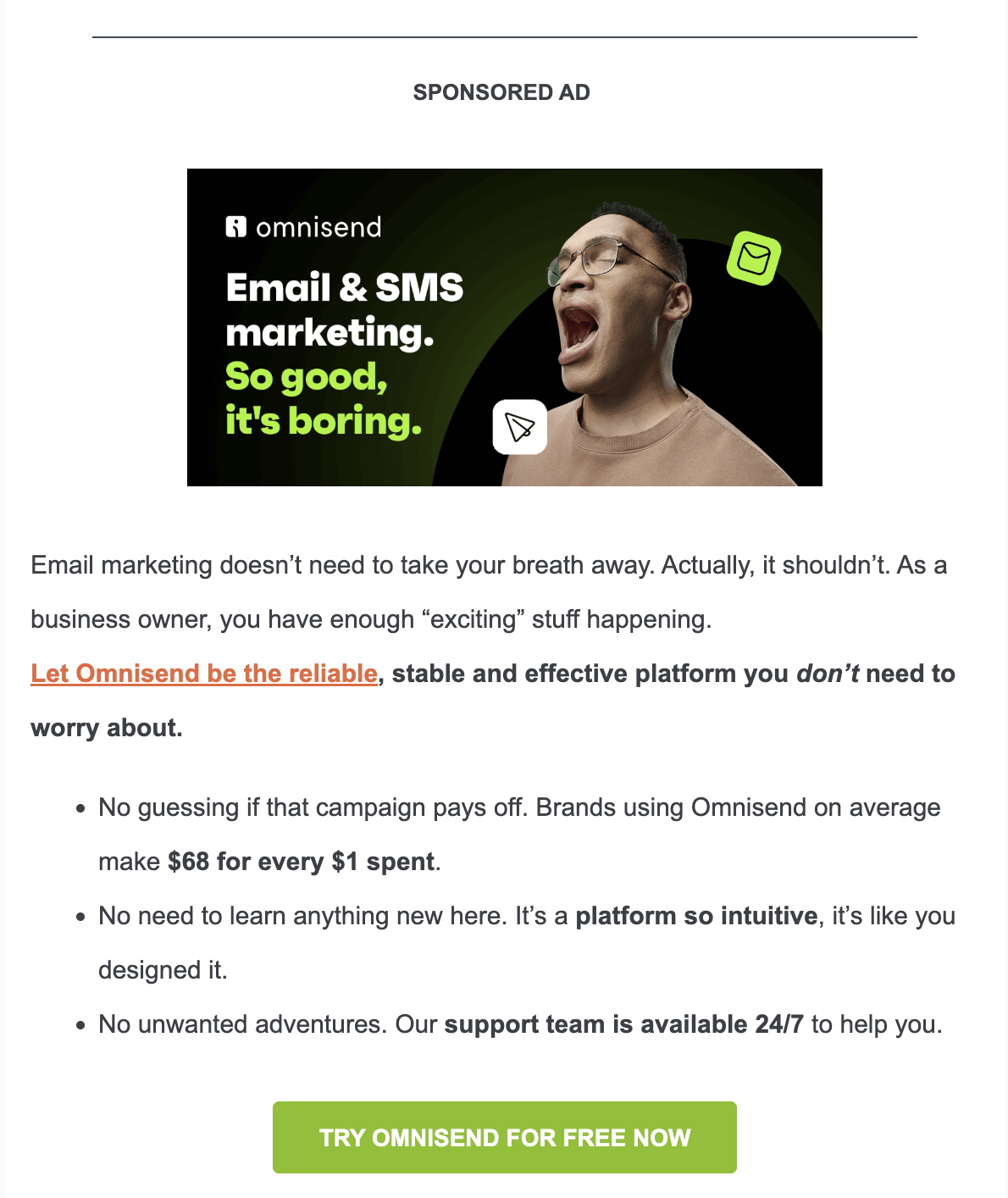
EmailTooltester’s newsletter ad example
This format shines when the product needs a little context before it clicks with readers. Instead of just throwing a logo at you, we wrapped it in a mini-story or endorsement.
Think:
- A money-saving app highlighted in a “Smart Money Habits” section.
- A book recommendation placed in a “What We’re Reading” roundup.
- A productivity tool woven into a “Work Smarter” feature in a business newsletter.
You might also spot editors using native placements in curated sections like “Our Favorite Tools” or “Top Picks of the Month”.
One thing to note: As a reader, it’s easy to confuse native ads with affiliate links. Both are embedded inside content and look like genuine recommendations. The difference is that:
- Native ad: The advertiser paid for the spot, and the publisher controls how it’s presented. If you see “Sponsored” or “In partnership with”—it’s a native ad.
- Affiliate link: Publishers include affiliate links to earn a commission if readers buy. If it feels more like a personal endorsement with a trackable link—it’s likely an affiliate.
4. Dedicated Email Blasts (Sponsored Sends)
Best for: High-intent offers, major launches, event promotions.
Got a big budget for newsletter ad space? Well, why not commission (or in the case of publishers, offer) a dedicated email blast.
A dedicated email blast helps brands get undivided attention because the email only focuses on the content they want to share. Because of that, they get to reap higher engagement and higher-intent leads.
For publishers, this means they can have higher CPMs.
Here’s an example of how SurveyMonkey used MarketingProf’s email list to announce their free 2-hour event:
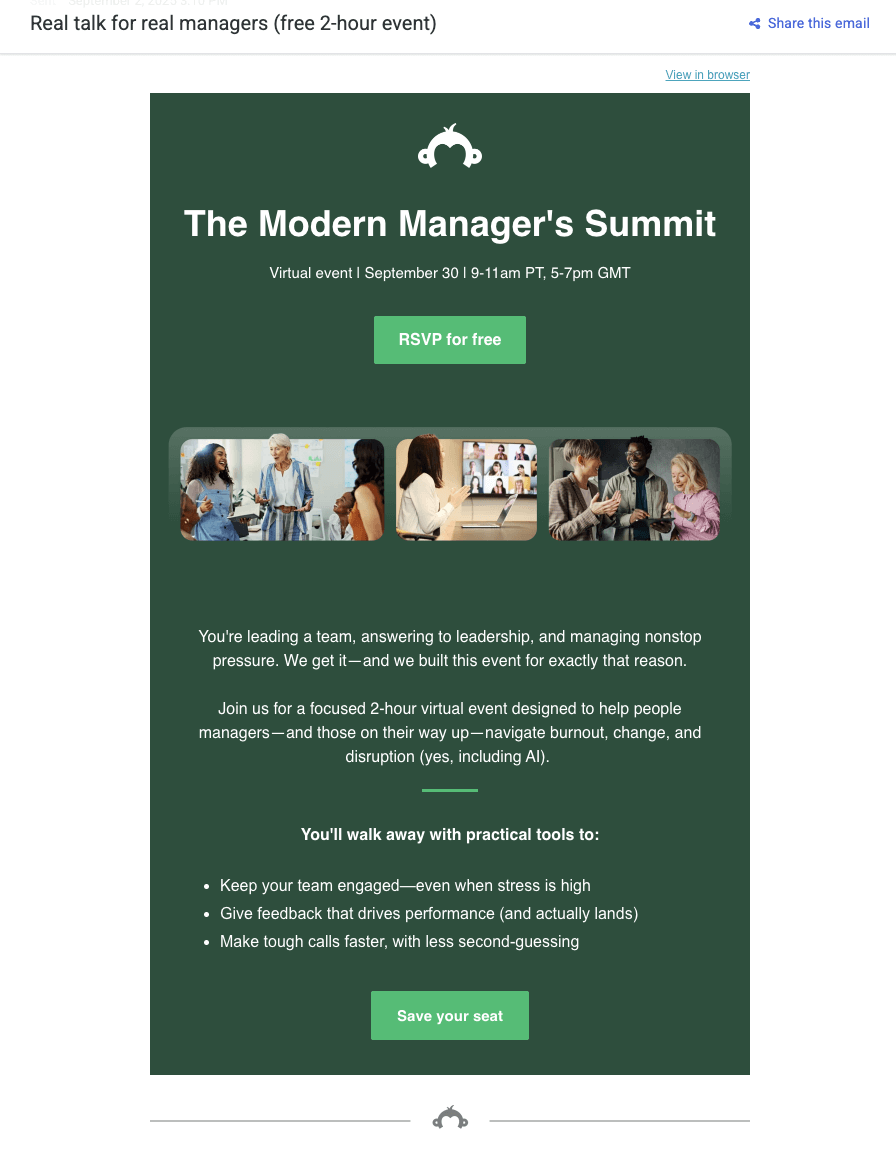
MarketingProfs’ newsletter ad example
Looking at the newsletter design layout, it’s likely that SurveyMonkey designed it themselves. But that doesn’t mean newsletter publishers can’t offer to draft a personalized message for a sponsored send.
5. Product Features or Spotlights
Best for: Storytelling, product demos, or showcasing benefits.
Second to banners, product features are probably one of the most straightforward ways to advertise. Although more conspicuous, adding a section like this feels closer to a recommendation than an ad because it’s presented within trusted editorial content.
Plus, once this section is established, readers get used to it—and may even start looking forward to it. That makes it feel less like a hard sell.
For example, one of my favorite newsletter creators, Gretchen Rubin, has an ad segment below her Five Things That Make Me Happy section for some feel-good products::
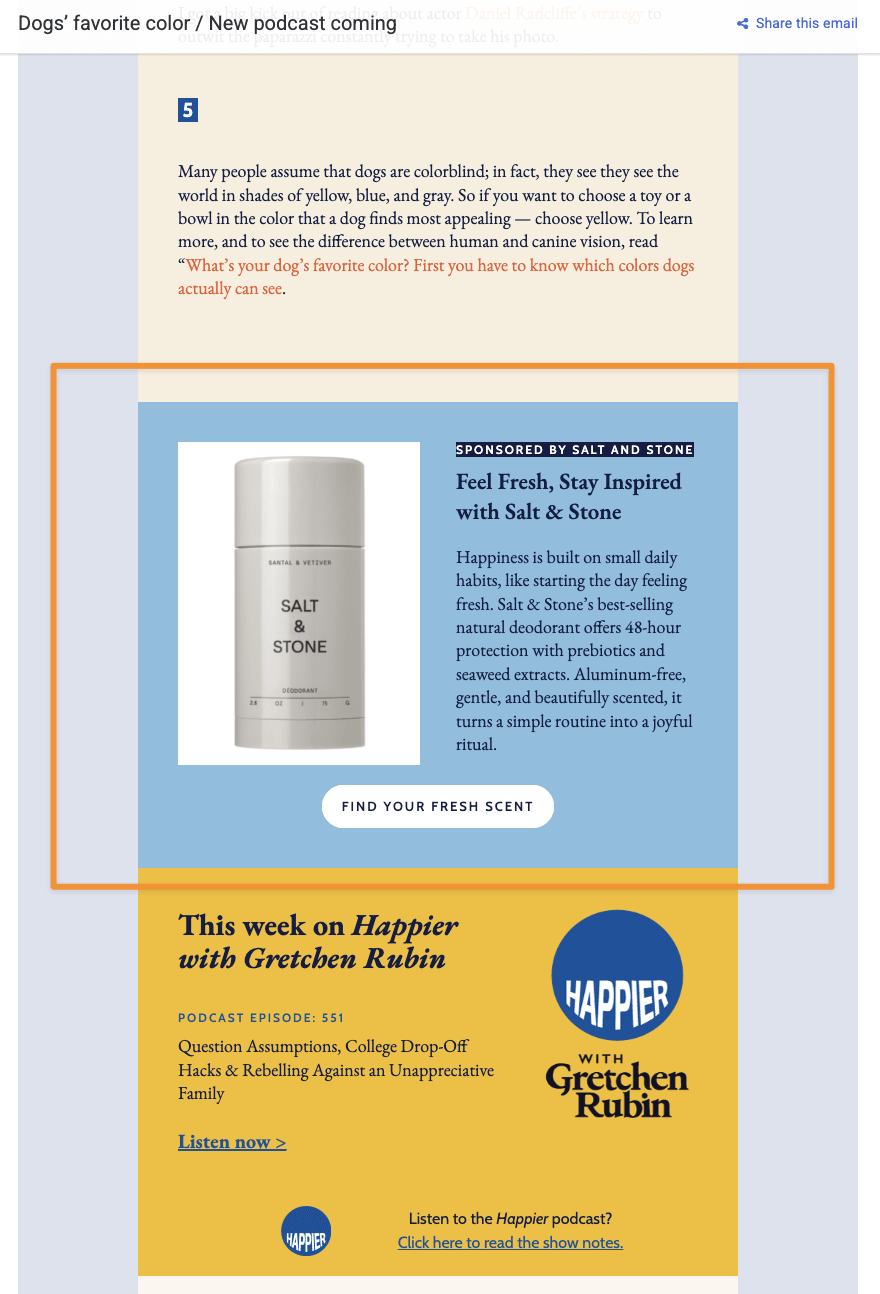
Gretchen Rubin’s newsletter ad example
Every issue spotlights a new offer. Here’s another example:
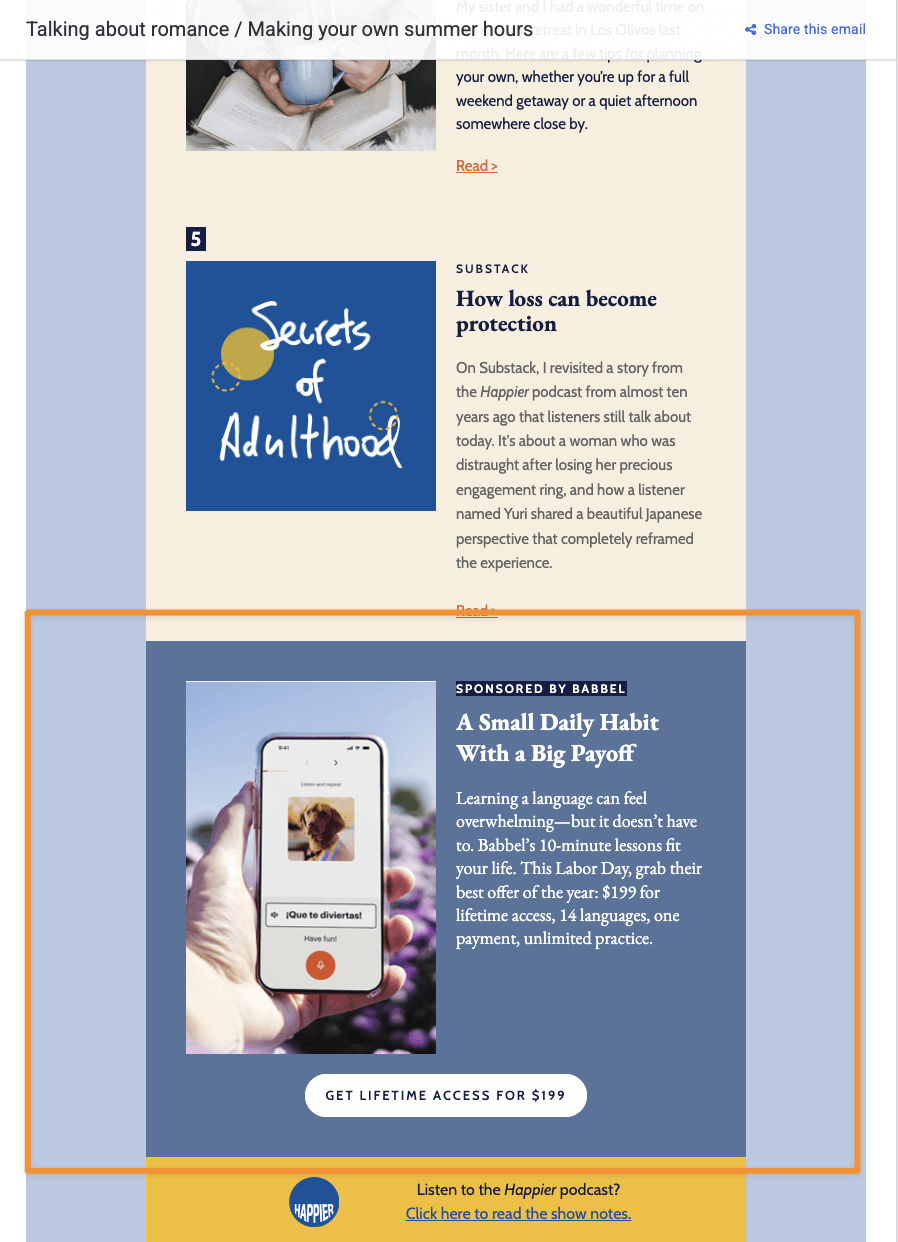
Gretchen Rubin’s newsletter ad example
I appreciate how Gretchen clearly labels the section as sponsored. By doing so, it becomes more transparent while still functioning as a product feature. And as you can see, with this ad format, marketers get to enjoy plenty of space to include compelling brand visuals and copy. This makes it perfect for highlighting a product or service’s unique selling points.
Don’t Forget: Mix and Match Is Always an Option
No need to lock yourself into one format. If you’ve got the budget, or if you’re running a premium newsletter, mixing and matching ad placements in a single issue can be a great practice.
For example, the in-text sponsored blurb mentioning Attio above wasn’t the only placement in Rosie Hoggmascall’s newsletter. Scroll down, and you’ll see a quick “thanks” to her sponsor, plus a bottom banner to seal the deal:
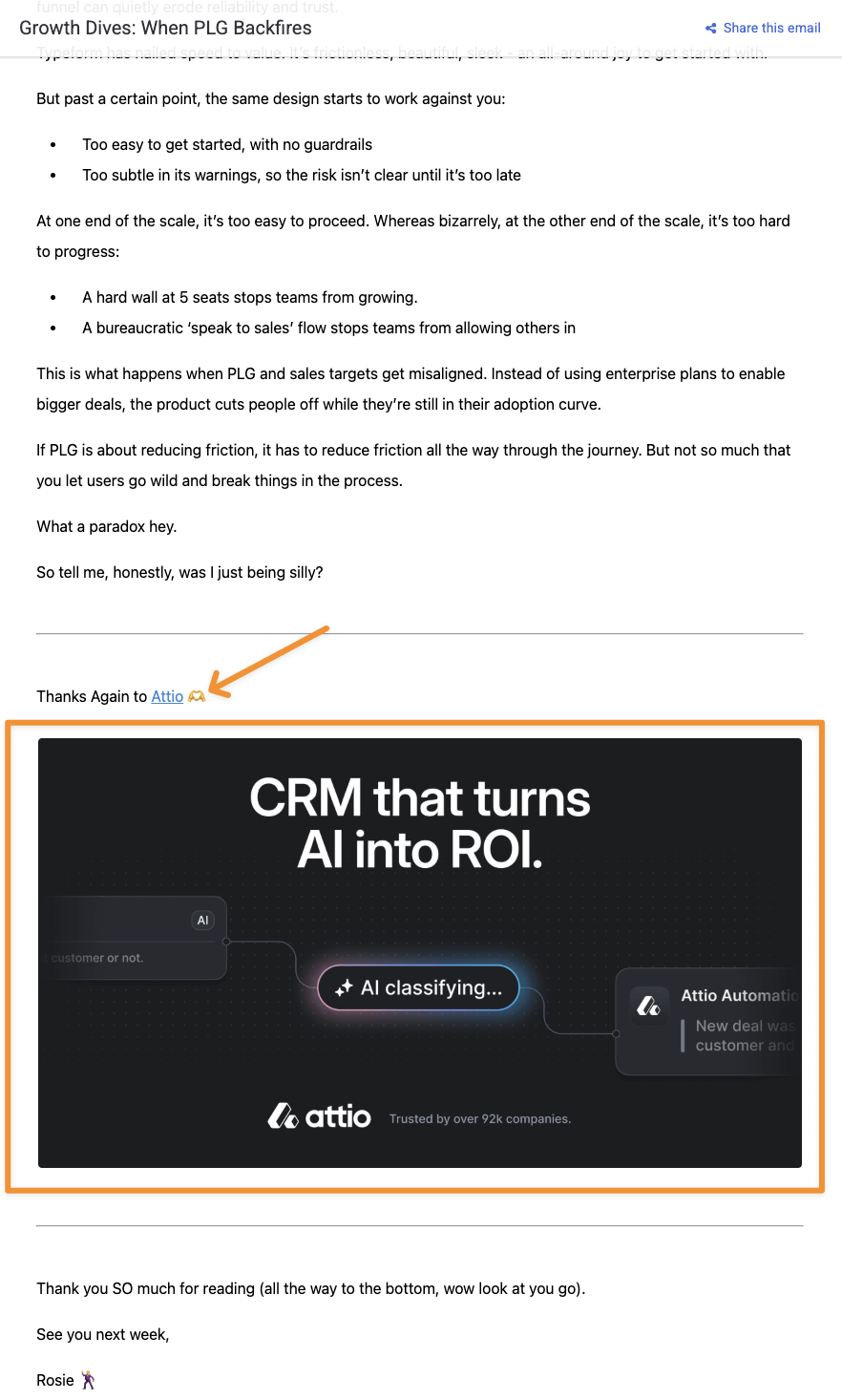
Growth Dives’ newsletter ad example
A clever move, since repetition across multiple placements reinforces recall without feeling repetitive. It also creates a mini-campaign inside one newsletter issue, where readers encounter the brand in different, complementary ways.
How to Place an Ad in a Newsletter for Brand Marketers
If you are planning to spend money on newsletter ads, make sure the newsletter fits your brand. Here are some golden tips to make sure your new ads don't miss the mark:
- Define your campaign goal. Your objective (ex: awareness, leads, or conversions) will determine if you need a large, general newsletter or a smaller, niche one.
- Check subscriber demographics. List size isn’t everything. A 10,000-subscriber newsletter full of your exact target audience is more valuable than a 100,000-subscriber list that isn’t relevant.
- Look at engagement rates. Open and click-through rates indicate how active the audience is. Smaller but highly engaged lists usually outperform large ones that barely open.
- Choose the right newsletter ad format. Match the format to your campaign goal and message. Quick visibility? Go with banners or short blurbs. Need more storytelling space? Try product spotlights or dedicated blasts. Scroll back up to see the breakdowns of each newsletter ad format above, along with examples, to guide your choice.
- Study the newsletter’s tone and style. Keep in mind: Alignment builds credibility. If the writing style or humor clashes with your brand voice, the ad may seem odd for readers. As you’ve seen in the examples above, the best newsletter ads integrate seamlessly without straying from the newsletter’s core purpose.
- Request a media kit. Publishers should be ready to share audience breakdowns, CTR averages, and pricing information. Make sure you go over the details, and feel free to ask questions.
- Read back issues. Subscribe and skim a few editions. Get a feel for what the newsletter is all about to make sure it is the right match.
- Watch for frequency. How often does the newsletter go out? Daily ads tend to get buried quickly. Weekly or biweekly placements often have a longer shelf life.
> Find the best marketplaces to buy newsletter ads here
Tips for Advertising Newsletter Space
If you’re a newsletter creator looking to sell ad space, make your offer attractive (and clear) to brands. Here’s some useful advice to help you with this:
- Know your value. It's not enough to say you have over X subscribers. Share your open rates, CTRs, reader demographics numbers, and audience quality—these are what make advertisers actually matter to advertisers.
- Offer multiple formats. Flexibility sells in the ad space, since every campaign is different. Offer the different newsletter ad formats mentioned above (banners, text ads, sponsored blurbs, product mentions, and dedicated sends).
- Be transparent about pricing. Brands don’t want to dig for numbers. Tell them straight what your fees are, whether you charge CPM, flat rate, or a package deal.
- Showcase past sponsors. Highlight ads you've run before to build social proof and give new advertisers confidence in your space.
- Aim for long-term partnerships. Don’t just sell one-off ads. Offer discounts or added value for multi-issue runs, like OutskillAI’s partnerships with platforms like Guidde and The Marketing Millennials:
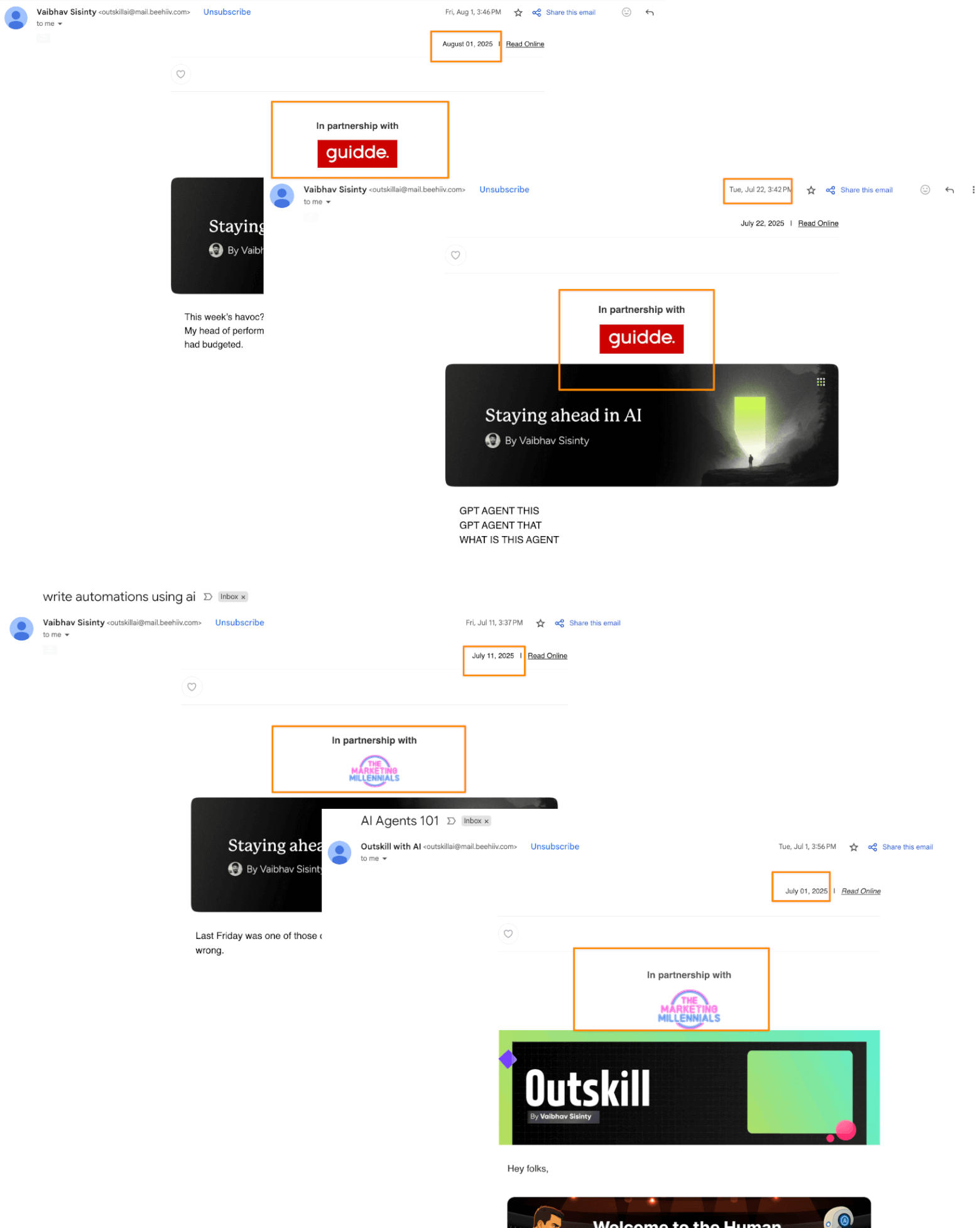
OuskillAI’s newsletter ad examples
- Make it easy to buy. Don’t overcomplicate things with long processes. Use a booking tool or simple email workflow, so brands can lock in placements quickly. Some newsletters advertise their space at the bottom of their newsletter issue, like so:
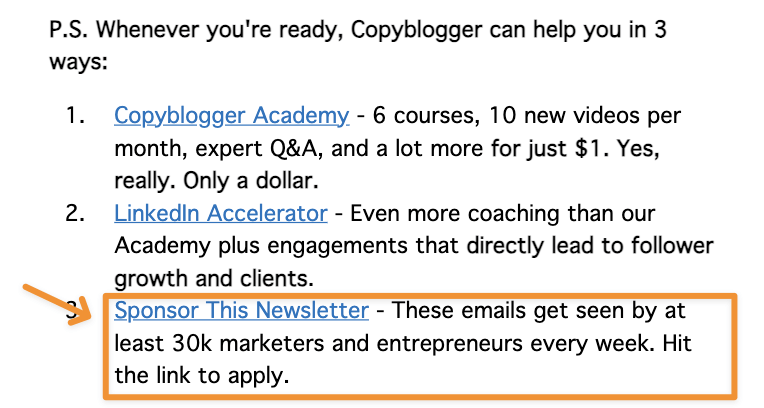
Example from Copyblogger
- Stay consistent with disclosures. Don’t break readers' trust. Always label “sponsored” content clearly.
- Track and share results. Ensure that advertisers' investments are well spent. Share post-campaign reports that include impressions, clicks, and engagement.
Make These Newsletter Ad Examples Work for You
Most digital ads are often loud and, to be honest, can feel disjointed to viewers.
Newsletter ads, however, are the quiet advantage. Readers have chosen to be there; they’ve invited that content into their inbox. Therefore, ads in every issue seem more natural and feel less like an intrusion when done well.
And as we’ve seen, the options aren’t one-size-fits-all. The right newsletter ad format depends on your goal, your audience, and the kind of message you want to deliver. That's why I included real-world examples above to illustrate how each format is applied.
Publishers win, too. Every placement, whether a spotlight, a blurb, or a full-blown sponsored send, creates new revenue streams without eroding reader trust (if done transparently). In fact, handled well, these placements can even enhance the newsletter by funding its growth and consistency.
And with that said, we have some good news: EmailTooltester’s very own newsletter is open for ad applications. That means if you’re a brand looking for a smart, engaged audience or a marketer who wants to test the power of this channel, you don’t have to look far.
With readers who actively seek out tools and insights, we’ll make sure your message lands where it matters most. Reach decision-makers and enthusiasts who are already primed to engage with products and services like yours.
Find out more about advertising with us here.
Our Methodology
This article has been written and researched following our EmailTooltester methodology.
Our Methodology